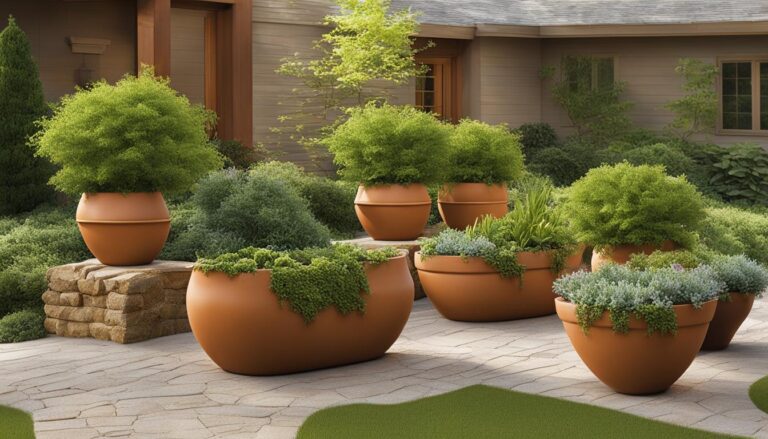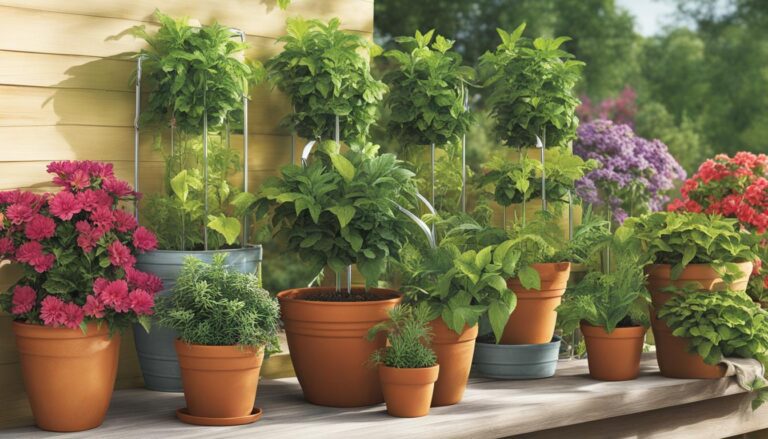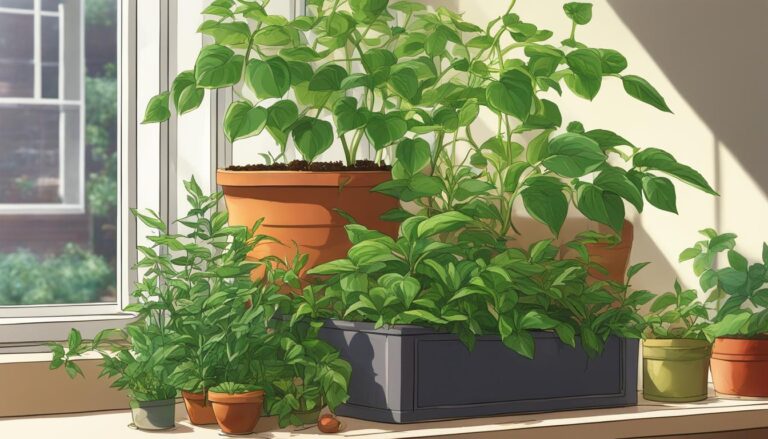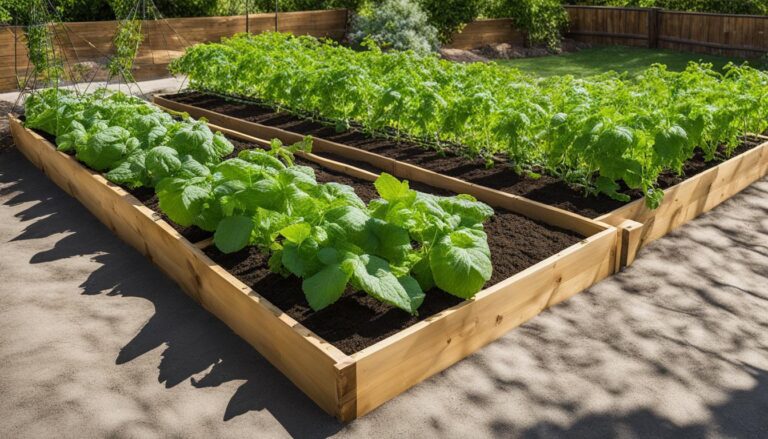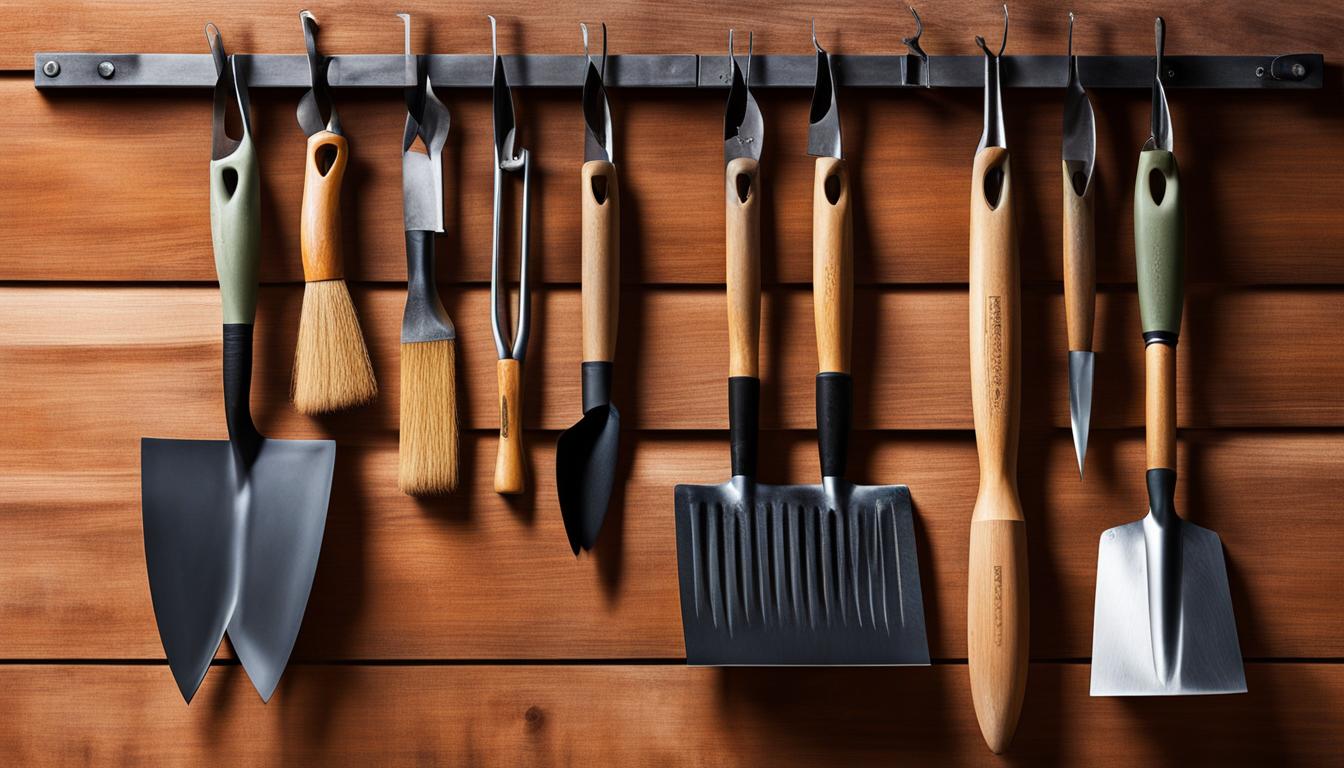
Welcome to my blog post on how to maintain gardening tools for longevity! Taking care of your garden tools is essential for their durability and effectiveness.
With proper maintenance, you can ensure that your tools last for years, saving you time and money in the long run.
In this article, I will share some expert tips and techniques for cleaning, sharpening, lubricating, and disinfecting your gardening tools. By following these maintenance practices, you can keep your tools in top condition and enjoy a successful gardening experience.
Key Takeaways:
- Regular care and maintenance of garden tools is crucial for their longevity.
- Clean and store tools properly to prevent rust and corrosion.
- Remove debris, sap, and rust from tools to keep them in good condition.
- Sharpen and oil tools regularly for efficient and effective use.
- Disinfect tools to prevent the spread of diseases and pests.
Why Garden Tool Maintenance is Important
Maintaining your garden tools is not only about keeping them in good condition, but it also plays a significant role in the overall success of your gardening endeavors.
Regular care and maintenance of your tools provide a range of important benefits that contribute to the efficiency, effectiveness, and longevity of your gardening tools.
One of the key reasons why garden tool maintenance is important is the prevention of the spread of diseases and pests. When your tools come into contact with bacteria, fungi, and insects in the soil, they can easily transport these problems to other areas of your garden.
By regularly cleaning and maintaining your tools, you can effectively prevent the spread of diseases and pests, ensuring the health and well-being of your plants.
Furthermore, properly maintained tools make your work quicker and easier. Sharp and clean tools perform better, allowing you to dig, prune, and trim with less effort. Dull or dirty tools, on the other hand, can make your gardening tasks more challenging and time-consuming.
By taking the time to maintain your tools, you can ensure that they are always in optimal working condition, making your gardening experience more enjoyable.
Importance of Garden Tool Maintenance
Overall, the importance of garden tool maintenance cannot be underestimated. By regularly cleaning, sharpening, lubricating, and disinfecting your tools, you can enhance their longevity, prevent the spread of diseases, and improve your overall gardening experience.
Taking care of your tools not only saves you money in the long run by extending their lifespan but also ensures that you have the right tools for the job when you need them the most. So, make it a priority to incorporate regular maintenance into your gardening routine for optimal results.
| Benefits of Garden Tool Maintenance |
|---|
| Prevents the spread of diseases and pests to maintain the health of your plants |
| Improves the efficiency and effectiveness of your gardening tasks |
| Extends the lifespan of your tools, saving you money in the long run |
| Enhances your overall gardening experience |
Regular Garden Tool Maintenance
Proper maintenance of your garden tools is essential for their longevity and optimal performance. By following these simple tips, you can ensure that your tools stay in good condition and continue to serve you well in your gardening endeavors.
Step 1: Clean After Each Use
After each use, it’s important to remove any soil and debris from your tools. Use a brush or cloth to wipe away dirt, and if necessary, scrub them with soap and water. This helps prevent the buildup of rust and keeps your tools in top shape.
Step 2: Store in a Dry Area
Proper storage is key to maintaining the quality of your garden tools. Store them in a well-ventilated area that is protected from moisture to prevent rust and corrosion. Consider hanging them on hooks or using a tool rack to keep them organized and easily accessible.
Step 3: Remove Sap and Rust
If your tools come into contact with sap or rust, it’s important to address these issues promptly. Use a wire brush or sandpaper to remove any rust spots, and clean off sap with a solvent or rubbing alcohol. Regularly inspect your tools for signs of damage and address them as soon as possible.
By following these regular maintenance tips, you can ensure that your garden tools remain in excellent condition, allowing you to enjoy your gardening tasks with ease and efficiency.
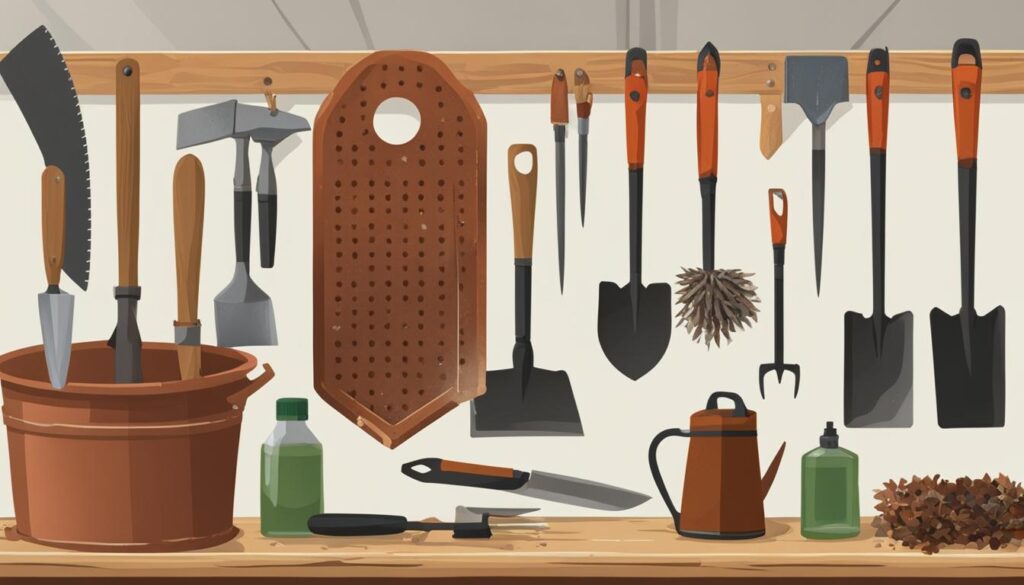
| Benefits of Regular Garden Tool Maintenance |
|---|
| Prolongs the lifespan of your tools |
| Prevents the spread of diseases and pests |
| Makes gardening tasks quicker and easier |
| Keeps tools in optimal working condition |
| Saves money by avoiding frequent tool replacements |
Seasonal Garden Tool Maintenance
Maintaining garden tools seasonally is essential for their longevity and optimal performance. By giving your tools some extra care at the end of the gardening season or just before spring, you can ensure that they are ready for another year of use. Here are some valuable tips for end-of-season tool maintenance:
Clean and Remove Debris
Before storing your garden tools for the season, it’s important to clean them thoroughly and remove any debris. Use a brush or a cloth to remove dirt, grass, and other organic matter from the blades, handles, and other parts of the tools.
Pay special attention to hard-to-reach areas where dirt and debris can accumulate. Cleaning your tools not only prevents rust and corrosion but also ensures that they are ready for use when the next gardening season rolls around.
Inspect and Repair
While cleaning your tools, take the time to inspect them for any signs of damage or wear. Check for loose screws or bolts, cracked handles, or dull blades. Repair or replace any damaged parts to ensure that your tools are in proper working condition. Properly maintained tools not only make gardening tasks easier but also help prevent accidents and injuries.
Apply Protective Coating
After cleaning and inspecting your tools, apply a protective coating to prevent rust and corrosion during storage. You can use a light oil or a rust inhibitor spray.
Apply the coating to all metal parts of the tools, including the blades, handles, and joints. Wipe off any excess oil to avoid attracting dust and dirt. The protective coating will help extend the life of your tools and keep them in good condition for the next gardening season.
| Tool | Cleaning Steps |
|---|---|
| Shovels and Spades | Remove soil and debris from the blades. Clean the handles and wipe them dry. |
| Pruners and Shears | Remove sap and debris from the blades. Apply oil to prevent rust. |
| Rakes | Remove leaves and other debris from the tines. Clean the handle and wipe it dry. |
| Hoes and Cultivators | Remove soil and debris from the blade. Clean the handle and wipe it dry. |
By following these tips for end-of-season tool maintenance, you can ensure that your gardening tools stay in optimal condition and are ready for another productive season.
Basic Garden Tool Maintenance in 3 Easy Steps
Proper maintenance of your garden tools is essential for their longevity and performance. By following these three simple steps, you can keep your tools in excellent condition and ensure they last for years to come.
Step 1: Sand
To start, inspect your garden tools for any splintering or roughness on the wooden handles. Use sandpaper to gently sand away any imperfections, creating a smooth and comfortable grip. This step not only improves the aesthetics of your tools but also prevents potential injuries from handling rough surfaces.
Step 2: Oil
Next, apply a thin coat of boiled linseed oil to the wooden handles of your garden tools. This oil acts as a moisturizer, preventing the wood from drying out and cracking over time. It also helps to protect the handles from moisture damage, extending their lifespan. Simply rub the oil onto the handles with a soft cloth, ensuring an even coverage.
Step 3: Dress
The final step is to dress the edges of your edge tools, such as shovels and hoes. Use a file or sharpening stone to remove any dullness or nicks on the cutting edges, ensuring a clean and precise cut.
This step is particularly important for maintaining the efficiency of your tools and preventing damage to your plants. Remember to wipe away any excess oil after sharpening to avoid a sticky residue.
By following these three easy steps – sand, oil, and dress – you can keep your garden tools in optimal condition. Regular maintenance will not only extend the lifespan of your tools but also enhance your gardening experience. So take a few minutes to care for your tools, and they’ll reward you with years of reliable service.
Cleaning and Sharpening Tools
Maintaining the cleanliness and sharpness of your garden tools is essential for their optimal performance and longevity. Clean tools not only prevent the spread of diseases and pests but also make your gardening tasks easier and more efficient.
Also, sharp tools provide clean cuts, reducing the risk of damage to plants. In this section, I will provide you with simple yet effective techniques for cleaning and sharpening your garden tools.
Cleaning Garden Tools
To clean your garden tools, start by removing any excess dirt and debris. Use a wire brush or a stiff-bristled brush to scrub away any stubborn residue. If your tools have accumulated sap or rust, consider using a mixture of vinegar and water or a specialized rust remover to dissolve these substances.
After cleaning, rinse the tools thoroughly with water and use a towel or cloth to dry them completely. Remember to pay special attention to the crevices and moving parts of your tools to ensure a thorough clean.
Sharpening Garden Tools
Sharpening your garden tools is crucial to maintain their cutting performance. For blades, such as pruners and shears, use a sharpening stone or a file to restore the sharp edge. Hold the tool securely and move the stone or file in a smooth motion along the blade, following the original bevel.
For shovels and hoes, use a file to remove any nicks or dull spots along the cutting edge. After sharpening, wipe away any metal filings and apply a thin coat of oil to prevent rusting. Remember to follow the manufacturer’s instructions and wear protective gloves when sharpening your tools.
| Tool | Cleaning Method | Sharpening Method |
|---|---|---|
| Pruners and Shears | Scrub with a wire brush and clean with vinegar-water mixture | Use a sharpening stone or file to restore the sharp edge |
| Shovels and Hoes | Scrub with a wire brush and clean with rust remover if necessary | Use a file to remove nicks and sharpen the cutting edge |
| Garden Forks and Rakes | Scrub with a wire brush and clean with soapy water | N/A |
Regular cleaning and sharpening of your garden tools will not only prolong their lifespan but also ensure that you have the right tools for every gardening task. By investing a little time and effort in maintaining your tools, you can enjoy a more productive and enjoyable gardening experience.
Lubricating Tools
Proper lubrication is key to maintaining the longevity of your garden tools and preventing rust and corrosion. By applying a thin coat of oil to your tools, you can protect the metal components and keep them functioning smoothly. There are a few key steps to follow when lubricating your garden tools.
Choosing the Right Lubricant
When selecting a lubricant for your garden tools, it is important to choose one that is bio-friendly and safe for the environment. Bio-friendly lubricants or natural oils like camellia seed oil are excellent options. Avoid using petroleum-based lubricants, as they can harm plants and the soil. Apply the lubricant to all moving parts and any exposed crevices of your tools.
Preventing Rust and Corrosion
By lubricating your garden tools, you create a protective barrier that helps prevent rust and corrosion. Rust can weaken the metal and make your tools less effective. Apply the oil after each use to ensure that the tools are well-protected. Regular lubrication will ensure that your gardening tools stay in good condition and last longer.
Proper Storage
After lubricating your tools, it is important to store them properly. Choose a well-ventilated, covered, and dry area for storage to prevent moisture from causing rust. Hang your tools or place them in a rack to keep them organized and prevent them from coming into contact with the ground. Storing your tools properly will extend their lifespan and keep them ready for use whenever you need them.
| Garden Tool | Lubrication Frequency |
|---|---|
| Pruners, shears, and secateurs | After each use |
| Shovels and hoes | Every few weeks |
| Rakes and forks | Once a month |
| Lawn mower blades | At the beginning and end of the mowing season |
Disinfecting Tools
Properly disinfecting garden tools is crucial for preventing the spread of diseases and ensuring the health of your plants. By taking the necessary steps to clean and disinfect your tools, you can eliminate harmful bacteria, fungi, and other pathogens that can contaminate your garden.
When it comes to disinfecting garden tools, it’s important to choose the right method and avoid using harsh chemicals that can damage the tools.
Instead of using bleach, which can cause metal to rust quickly, opt for safer alternatives. Rubbing alcohol or disinfecting wipes are effective in quickly cleaning tools and removing sap, bacteria, and fungus.
Simply wipe down the tools thoroughly, paying extra attention to areas that may have come into contact with diseased plants or pests.
Regularly disinfecting your garden tools is especially important if you work with a variety of plants or if you’ve noticed any signs of disease or infestation in your garden.
By maintaining clean and disinfected tools, you can prevent the spread of diseases and ensure that your garden remains healthy and thriving.
Checking and Cleaning Tools
Regularly checking and cleaning garden tools is important for maintaining their longevity and ensuring optimal performance. By following a few simple steps, you can keep your tools in top condition and extend their lifespan.
Step 1: Wipe off Dirt and Debris
- After each use, take a moment to wipe off any dirt, mud, or debris from your tools. This will prevent buildup and make it easier to clean them thoroughly later.
- Use a damp cloth or sponge to remove any stubborn dirt or sap. If necessary, you can also use a soft brush to scrub away any residue.
Step 2: Wash with Soapy Water
- Fill a bucket or sink with warm water and add a few drops of dish soap or a mild detergent.
- Submerge your garden tools in the soapy water and use a sponge or brush to scrub away any remaining dirt or residue.
- Rinse the tools thoroughly with clean water to remove all soap and suds.
Step 3: Dry Completely
- After washing, make sure to dry your tools thoroughly to prevent rust and corrosion.
- Use a clean, dry cloth to wipe away any excess moisture.
- If necessary, you can also let your tools air dry in a well-ventilated area.
Following these steps on a regular basis will help maintain the hygiene and performance of your gardening tools. By keeping them clean and free from debris, you’ll ensure that they are always ready for use and will last for many seasons to come.
Sharpening and Maintaining Edges
Maintaining sharp edges on your garden tools is crucial for ensuring clean and efficient cutting. Sharp tools not only make your gardening tasks easier but also help prevent damage to your plants. Here are some tips for sharpening and maintaining the edges of your garden tools:
Sharpening Blades
- Use an oil stone, handheld file, or sharpening tool designed specifically for blades to sharpen your garden tool edges.
- Follow the original angle of the blade when sharpening to maintain its cutting performance.
- Start from the base of the blade and work your way towards the tip, making smooth and even strokes.
- Repeat the sharpening process until you achieve a sharp, clean edge.
Removing Nicks and Burrs
- If there are any nicks or burrs on the blade, use a fine-grit sharpening stone or sandpaper to gently remove them.
- Hold the tool firmly and move the stone or sandpaper along the edge, applying light pressure until the nicks and burrs are smoothed out.
- Be careful not to remove too much metal, as this can shorten the lifespan of your tool.
Maintaining Cutting Performance
After sharpening your garden tool edges, it’s important to maintain their cutting performance. Here are some additional tips:
- Remove any excess oil from the blades using a clean cloth or paper towel to prevent it from attracting dirt and debris.
- Regularly inspect the edges for signs of wear or damage, and address any issues promptly.
- Store your tools in a clean, dry area to protect them from moisture and rust.
- Consider using a blade cover or sheath to keep the edges protected when the tools are not in use.
By following these tips, you can keep your garden tool edges sharp and maintain their cutting performance, making your gardening tasks more efficient and enjoyable.
General Maintenance Tips
When it comes to garden tool maintenance, there are a few general tips to keep in mind. These practices will help you keep your tools in good condition and ensure their longevity.
Firstly, consider hanging your tools instead of standing them. This will prevent them from getting damaged or bent. Hanging also keeps them within easy reach, making your gardening tasks more efficient.
Another important step is to brush off any soil and debris from your tools after each use. This will prevent dirt from accumulating and potentially causing damage. Once cleaned, allow the tools to dry thoroughly before storing them.
Disinfecting your tools regularly is also essential for maintaining their hygiene. Use a disinfectant solution to kill off any diseases or pests that may be lingering on the tools. This will help prevent the spread of harmful pathogens to your plants.
Lastly, don’t forget to sand and oil the wooden handles of your tools. This will prevent the wood from drying out and cracking. Apply a thin layer of oil, such as boiled linseed oil, to keep the handles moisturized and protected.
By following these general maintenance tips, you can ensure that your garden tools stay in excellent condition and serve you well for many years to come.
FAQ
How often should I clean and maintain my garden tools?
It is recommended to clean and maintain your garden tools after each use, and give them extra care at least once per year.
How do I clean my garden tools?
Clean off any soil and debris, scrub if necessary, and wash tools with soap and water if they come into contact with diseased plants or unwanted substances.
How can I remove rust from my garden tools?
Soak smaller tools in vinegar and water, and use sanding, sharpening, and oiling techniques to remove rust from larger tools.
How should I store my garden tools?
Store tools in a well-ventilated, covered, and dry area to prevent rust and corrosion.
How do I sharpen my garden tools?
Use a hand-held file, rasp, or honing stone to sharpen tools, and consider professional maintenance for tools with serrated edges.
What type of oil should I use to lubricate my garden tools?
Use bio-friendly lubricants or camellia seed oil to protect the metal components of your tools.
How do I disinfect my garden tools?
Use rubbing alcohol or disinfecting wipes to quickly clean tools and remove sap, bacteria, and fungus. Avoid using bleach.
How often should I check and clean my garden tools?
Regularly check and clean your garden tools after each use to ensure their longevity and performance.
How do I maintain the sharpness of my garden tool edges?
Apply oil and file the edges of your garden tools to maintain their cutting ability.
What are some general maintenance tips for garden tools?
Hang tools instead of standing them, brush off soil after use and allow tools to dry before storing, tighten loose bolts when necessary, and sand and oil wooden handles to prevent drying out.

